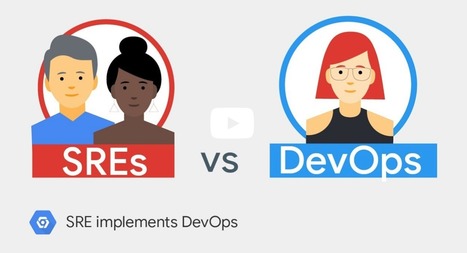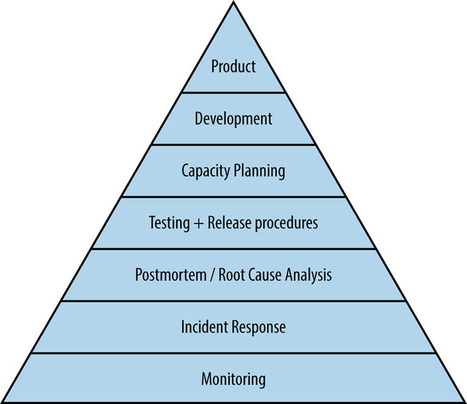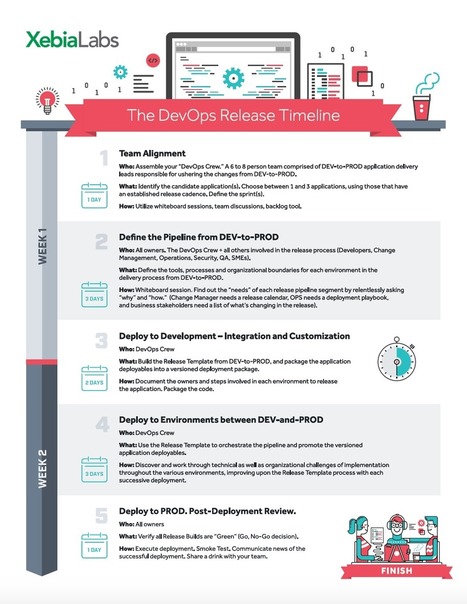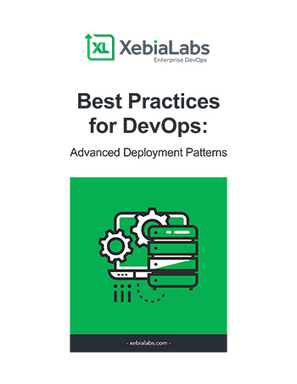 Your new post is loading...
 Your new post is loading...

|
Scooped by
Mickael Ruau
June 28, 2019 8:09 AM
|
Review for Accelerate — The Science of Lean Software and DevOps: Building and Scaling High Performing Technology Organizations with thoughts, highlights, and lastly a recommendations

|
Scooped by
Mickael Ruau
June 28, 2019 7:58 AM
|
As DevOps has matured, so has the reading list on advanced topics. We talked to practitioners to come up with our must-reads.

|
Scooped by
Mickael Ruau
June 20, 2019 1:44 AM
|
DevOps emerged as a culture and a set of practices that aims to reduce the gaps between software development and software operation. However, the DevOps movement does not explicitly define how to succeed in these areas. In this way, DevOps is like an abstract class or interface in programming. It defines the overall behavior of the system, but the implementation details are left up to the author. SRE, which evolved at Google to meet internal needs in the early 2000s independently of the DevOps movement, happens to embody the philosophies of DevOps, but has a much more prescriptive way of measuring and achieving reliability through engineering and operations work. In other words, SRE prescribes how to succeed in the various DevOps areas. For example, the table below illustrates the five DevOps pillars and the corresponding SRE practices:

|
Scooped by
Mickael Ruau
June 5, 2019 9:29 AM
|
This evolution of the Wikipedia definition is indicative of the evolution of DevOps itself and how the industry views DevOps. Other than the replacement of the esoteric portmanteau, which had everyone going to Dictionary.com, the key points to note are as follows: - Replacement of ‘software development method’ with ‘culture, movement, or practice’.
- Addition of the reference to automation.
- Change of the end-goal from ‘rapidly producing software products’ and ‘services to building, testing, and releasing software, which can happen rapidly, frequently, and more reliably’.
This is recognition of the fact that the goal of DevOps has changed from being just speed, to being speed, reliability, and quality (#faster and #better). Of course, I would be remiss not to mention what I believe is the most concise definition of DevOps ever written; I saw this first on a T-shirt at the O’Reilly Velocity Conference back in 2013: “DevOps—taking the SH out of IT!”

|
Scooped by
Mickael Ruau
May 17, 2019 1:47 AM
|
Optimize your time and learn faster! I've read The DevOps Handbook, filtered the information, and have summarized all the key points for you.

|
Scooped by
Mickael Ruau
May 9, 2019 9:42 AM
|
DevOps and Continuous Delivery Terms Defined!

|
Scooped by
Mickael Ruau
May 6, 2019 9:23 AM
|
DevOps is a fast growing field – a movement. Like any new technological advancement or new ‘movement’ that takes the Application Delivery world by storm, learning about DevOps is like drinking from a firehose. My series on Understanding DevOps is geared towards executives, decision makers and practitioners who are new to the field, are learning the terminology and attempting to cut thru the fluff and hype and get to the meat and potatoes (did I miss any idiom?). My attempt is to do exactly that – present a tool and technology agnostic description of the field and advances thereof. I will from time to time talk about technologies and tools that are relevant to the field of DevOps, but will try to keep an un-biased perspective (Full disclosure – I have worked for IBM in the past, and currently work for Delphix).

|
Scooped by
Mickael Ruau
April 21, 2019 2:04 PM
|
Comment le Chaos Engineering a permis à OUI.sncf de mettre à l'épreuve son monitoring et d'évaluer son niveau d'observabilité.

|
Scooped by
Mickael Ruau
March 27, 2019 3:48 AM
|
Thoughts, take-aways, and a recommendation for “The DevOps Handbook: How to Create World-Class Agility, Reliability, & Security in Technology Organizations“

|
Scooped by
Mickael Ruau
February 3, 2019 9:32 AM
|
Automate your infrastructure deployments and configurations with these Infrastructure as Code tools.

|
Scooped by
Mickael Ruau
January 26, 2019 10:21 AM
|
Jointly written by Scrum.org and the DevOps Institute, this paper looks at how modern IT operates and how the different parts of the organization can work together to deliver working software with greater agility.

|
Scooped by
Mickael Ruau
January 14, 2019 8:36 AM
|
En quelques années, la méthode DevOps, qui vise à améliorer la mise en œuvre et la qualité de projets informatiques, a connu un développement fulgurant. Découvrez l'histoire du DevOps en quelques dates !

|
Scooped by
Mickael Ruau
December 29, 2018 8:09 AM
|
La chaîne d'outils Devops est une collection ou une combinaison d'outils qui aide dans la distribution, le développement et la gestion d'applications tout au long du cycle de développement (logiciel). Chaque entreprise qui utilise la méthode DevOps la coordonne.
|

|
Scooped by
Mickael Ruau
June 28, 2019 8:07 AM
|
High performing organizations don't trade off quality, throughput, and reliability: they work to improve all of these and use their software delivery capabilit…

|
Scooped by
Mickael Ruau
June 20, 2019 6:25 AM
|
Tayllan's adventures through the worlds of Web Development, Software Architecture, DevOps and SRE!

|
Scooped by
Mickael Ruau
June 12, 2019 2:01 AM
|
Slack time is vital to growth

|
Scooped by
Mickael Ruau
June 3, 2019 8:43 AM
|
When we first penned the eight laws of developer platforms back in 2013, we didn’t chisel them in stone. We always knew they were a living document. Five years and a dozen investments later, in companies like LaunchDarkly, HashiCorp, and PagerDuty, we recognize these laws as not just investing criteria that led us to some of the most successful developer-centric businesses, but also as practical case studies for developer-focused entrepreneurs who want to do the same. Founders today face a completely different reality than founders had to navigate six years ago, and these three trends have impacted the way entrepreneurs build companies in today’s era of enterprise IT

|
Scooped by
Mickael Ruau
May 14, 2019 2:32 AM
|
The DevOps Release Timeline is a guide for your team’s first DevOps sprint. We’ve broken this timeline into 5 steps over a two-week period.

|
Scooped by
Mickael Ruau
May 9, 2019 9:03 AM
|
Getting new software to your users without interrupting their experience is hard; how do you upgrade an application that’s inactive use?

|
Scooped by
Mickael Ruau
April 30, 2019 10:06 AM
|
Des Devs s’arrogeant la place des Ops, des Ops acquérant des compétence de Dev… Dans cette session, nous vous proposons ainsi d’explorer ces profondes mutations culturelles et techniques, et nous vous partagerons quelques recettes pour le plus grand bénéfice des OPs… comme des DEVs. Comme l’écrivait Audiard, « Quand ça change, ça change... Faut jamais se laisser démonter » !

|
Scooped by
Mickael Ruau
April 19, 2019 4:09 AM
|
« La Servuction, c’est la manière dont un prestataire manage son entreprise et surtout son client afin de délivrer son Service avec la meilleure Qualité possible, tout en respectant ses objectifs économiques. »

|
Scooped by
Mickael Ruau
February 28, 2019 9:56 AM
|
1h d’indisponibilité = 1 M€ de perte Découvrez comment Voyages-sncf.com s’est appuyé sur la démarche DevOps pour innover et garantir un Time To Market concurre…

|
Scooped by
Mickael Ruau
January 30, 2019 8:04 AM
|
This session will walk you through a practical framework for implementing measurement and tracking of your DevOps efforts and software delivery performance that will provide you with data you can act on! These KPIs include metrics related to your software delivery pipeline and technical progress, as well as cultural indicators and business impact. In addition, we will cover common use cases and real world examples for implementing these metrics to drive DevOps success, as well as best practices for how to address certain challenges and problematic areas along your process that these metrics may bring to light.

|
Scooped by
Mickael Ruau
January 22, 2019 5:56 AM
|
MetricsDrivenDevelopmentandDevOps.pdf

|
Scooped by
Mickael Ruau
January 14, 2019 5:23 AM
|
The research recommends this action plan to more fully implement agile and DevOps: - Measure business impact.
- Address skill gaps early.
- Be agile everywhere, not just in IT.
- Eliminate DevOps silos.
- Don’t compromise security.
- Optimize your investments.
- Remember the big picture.
|
 Your new post is loading...
Your new post is loading...
 Your new post is loading...
Your new post is loading...












![[INFOGRAPHIE] Petite histoire de la méthode DevOps | Devops for Growth | Scoop.it](https://img.scoop.it/RRMqyEpyG7wFxmlt_DwHfTl72eJkfbmt4t8yenImKBVvK0kTmF0xjctABnaLJIm9)













Accelerate puts a finger on measuring software delivery performance. This a fuzzy problem since feel like part of a high performing, but it’s challenging to compare performance across teams for a multitude of reasons. Their measurement works around these problem with directly observable metrics and inferred metrics. They break software delivery performance into four metrics: